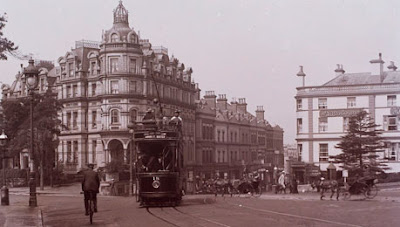The Bournemouth International Centre
The Bournemouth
International Centre was opened in 1984 on the site of aging hotels in Cliff
Cottage and South Cliff roads. Sir Patrick Abercrombie had suggested developing
the site in the 1940s. In the early 1980s plans were fiercely debated, with
Council meetings lasting 8 hours, over the £16 million cost. The centre was
intended to host 4,000 conference delegates, boxing matches and tennis
championships. There was to be a 73,000 sq ft swimming pool and a multi-story
car park.
Early design included a
series of glass-fibre tents and a three-star tower-block hotel. ‘Module 2’, the
company which won the contract, began with a design like a dalek spaceship. The
Council funded the centre by selling the Pier Approach Baths, land on the West
Cliff and 45 acres of land at Littledown.
The Royal Fine Art
Commission said of the design, that Bournemouth Council had ‘irrevocably
damaged one of the most sensitive sites on the South Coast’. Supporters
believed the BIC would put Bournemouth into the ‘European First League’. Work
on the new structure started in March 1982; controversy dogged decisions to
award the ventilation system to a Dutch company, and the marketing to a company
based in Brighton – Bournemouth’s biggest competitor.
By July 1983, a new
conference centre manager had been appointed – Mr Luis Canda – he forecast that
the centre would extend the holiday season at Bournemouthm from 8 to 16 weeks
in the summer. Mayor Jeanne Curtis officiated at the topping out ceremony in
July 1983.
he centre was opened in
September 1984, by Mayor Cllr Michael Filer, who declared that it marked the
beginning of Bournemouth’s future. Visitors on the opening day could see the
‘Community Awareness’ exhibition, including two double-decker busses, in the
main hall (which comedienne Victoria Wood later described as ‘like the loading
bay at British Home Stores’. Outside, on opening day, language students raised
flags of all the European countries.
The Centre has an early
success with a visit by Johnny Mathis, which brought Town Centre traffic to a
halt. At her later concert Shirley Bassey looked around the hall and commented
‘It will be nice when it’s finished’. 1,500 delegates from the Labour Party
used the BIC for their conference in 1985. In September 1986 the Conservative
Party arrived with PM Margaret Thatcher and (in the wake of the Brighton
bombing) a £1 million security bill.
With a large Conservative
Party conference planned for 1990, money was raised to build a £4.6million
flying-saucer extension. Having run for 5 years, the BIC had made a modest
profit of £60,000, but brought an estimated £20 million worth of business to
Bournemouth.
Michael Stead, Heritage
Team, Bournemouth Libraries




 The Lansdowne - Lansdowne Hotel on the right and Queen Hotel on the left.
The Lansdowne - Lansdowne Hotel on the right and Queen Hotel on the left.












 The square 1873
The square 1873
.jpg)

